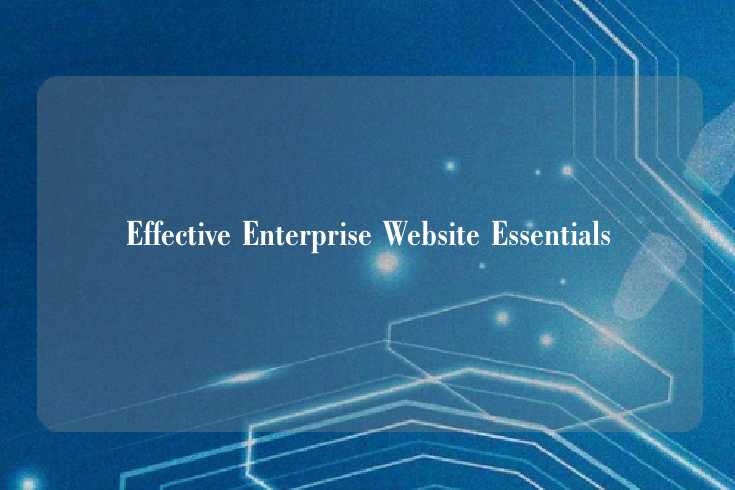
当然,请提供您希望被总结的内容,以便我为您生成摘要。

In the digital era, a professional and user-friendly enterprise website is indispensable for businesses aiming to reach their target audience effectively. Regardless of whether you are a small startup or a large corporation, your online presence can significantly influence customer engagement and sales.
<img src="https://www.56dr.net/news/zb_users/upload/zltheme_20250316/34dbfddde184f8d592e4771b29442fea.jpg" alt="Effective Enterprise Website Essentials" />
This article delves into the essential components that should be included in an enterprise website to ensure it serves its purpose efficiently.
1. Professional Design and User Interface
The first impression of your business on the web matters greatly. A well-designed website not only looks good but also ensures ease of navigation. Employ a clean and modern layout, incorporating high-quality visuals and maintaining consistent branding across all pages. Ensure the design is mobile-responsive, adapting seamlessly to different screen sizes—from desktops to smartphones.
2. Clear Navigation and Easy Accessibility
Your website must be easy to navigate for users to find what they need quickly. Organize your site with a clear hierarchy, such as a main menu with sub-menus leading to more specific sections like "About Us," "Services," "Products," "Contact," etc. Implement search functionality to help visitors find information easily.
3. Intuitive Forms and Contact Mechanisms
Ensure your contact forms are simple and straightforward. Include fields for name, email address, phone number, and any additional details required. Highlight these forms prominently and make them accessible at the top or bottom of your site. Additionally, provide multiple contact options—email, phone, live chat, and social media links—to cater to different preferences.
4. Content Marketing and SEO Optimization
Quality content is vital for attracting and retaining visitors. Publish blog posts, articles, case studies, and guides related to your industry to establish yourself as an authority. SEO optimization helps improve visibility in search engine results. Optimize meta titles, descriptions, headers, and images with relevant keywords while maintaining quality content.
5. E-commerce Integration (For Businesses Selling Products)
If your business sells products or services online, integrating e-commerce features is essential. Enable secure payment gateways like PayPal, Stripe, or Square to facilitate transactions. Display product listings, reviews, pricing, and shipping information clearly. Consider adding a shopping cart feature and possibly a wishlist or subscription service for repeat customers.
6. Security Measures
Ensure your website is secure to protect user data and prevent unauthorized access. Use HTTPS encryption to secure data transmitted between the browser and server. Regularly update software, plugins, and operating systems to patch vulnerabilities. Educate your team about cybersecurity best practices and conduct regular security audits.
7. Social Media Integration
Leverage social media platforms to increase brand awareness and engage with customers. Integrate social sharing buttons on your website so users can share your content easily. Utilize social media for promotions, news updates, and direct interaction with followers.
8. Mobile Optimization
With the majority of internet traffic now coming from mobile devices, optimizing your website for mobile is imperative. Responsive design adjusts the layout automatically based on the device being used, ensuring a seamless experience on smartphones and tablets.
9. Dynamic Features and Analytics
Incorporate dynamic features such as interactive maps, virtual tours, or augmented reality experiences to enhance user engagement. Set up analytics tools like Google Analytics to track visitor behavior, identify trends, and optimize your website accordingly.
10. Community Engagement and Feedback Loop
Establish a community forum or blog where customers can share their thoughts, ask questions, and provide feedback. Respond promptly to comments and suggestions to foster a sense of belonging and loyalty.
Conclusion
By incorporating these key elements into your enterprise website, you can create a powerful online platform that not only drives traffic but also strengthens your brand reputation and fosters customer loyalty. Remember, an effective enterprise website requires continuous updates and improvements to stay current and relevant in the ever-evolving digital landscape.
希望这个版本能满足你的需求,并且能够帮助你的企业提升在线表现。